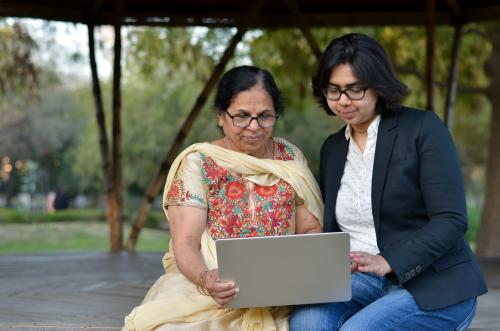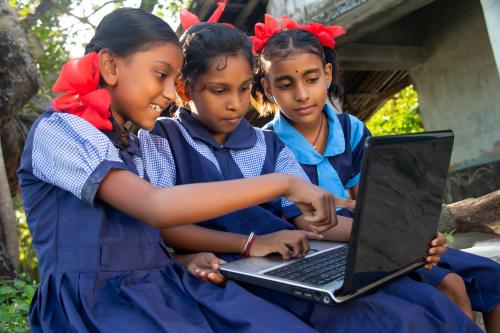Imagine a room full of university students in India: young men and women sitting shoulder to shoulder in equal numbers. Fast forward 10 years: 8 out of 10 of those men are likely to be active in the workforce compared to only 3 out of 10 women. This example illustrates one of the great conundrums of India’s female labor force: a low and rapidly declining participation rate—even before the COVID-19 pandemic—despite economic growth and women’s increasing enrollment across all levels of education, and in particular tertiary education (sometimes referred to as post-secondary education; see Figure 1).

Young women in India face numerous and intersecting challenges that affect their workforce participation, chief among them, the triple impact of a skills deficit, a network gap, and restrictive gender norms.
Skills deficit: Tertiary curricula rarely address 8 of the 10 skills employers today value most, which relate to problem-solving, self-management, and working with people, and they are seldom built through traditional instructional approaches in classrooms.
Network gap: Women in India tend to have small professional networks because social norms restrict them from engaging freely. A lack of role models can limit aspirations, lower beliefs in personal abilities, and reduce women’s likelihood of breaking gender stereotypes and entering academic or career paths where they do not see other women.
Restrictive gender norms: Social norms defining a woman’s role as primarily that of a caregiver are one of the main factors discouraging female labor force participation (FLFP) in India. In urban areas, women’s participation in the labor force drops off in their early to mid-20s—when marriage- and family-related responsibilities tend to increase—yet unlike in other countries, especially in urban areas, only few women in India reenter the workforce later.
Reversing the decline in women’s labor force participation is critical to India’s economic and social recovery from the COVID-19 pandemic.
There is compelling evidence that these three causal factors for low FLFP highlighted are indeed malleable. But for the 19 million young women currently enrolled in tertiary education in India, can we tackle these three factors at scale and set women on a trajectory that allows them to enter and thrive in the labor force?
In my policy brief “Unlocking young women’s economic potential through digital mentoring in India,” I provide evidence that digital mentoring would be widely accessible given women’s rapidly growing use of technology and is an effective way to tackle these three problems at scale (Figure 2); I also provide detailed recommendations to help create a policy and practice ecosystem that would deliver quality digital mentoring at scale and help unlock women’s potential in the workforce.
Figure 2. Digital mentoring facilitates skills exchange, network expansion, and modeling of gender-transformative social norms
Source: Author’s conceptualization, with original design support from Jonathan McKay.
Based on a case study of a single mentoring program, Mentor To Go (MTG), which included participation from 1,000 young people between March 2020 to April 2021, I learned the following:
- Digital mentoring reached girls from low-income families across 10 Indian states, with two state government partnerships in Karnataka and Telangana, which helped drive uptake of the program among girls. Although women had not been specifically targeted, they comprised 61 percent of total enrollment in the MTG program and were 89 percent more likely than young men to complete all the eligibility requirements.
- Young women mentees built up their work readiness and life skills. An evidence-based work readiness mentoring curriculum and personalized guidance from mentors helped the women improve their skills.
- Virtual mentoring created a large and diverse network of career mentors and role models across India. Mentees valued that the mentors were carefully vetted and screened, which increased their trust in the network.
- A mentoring network’s egalitarian gender norms can be a driving force to help change social norms. With so many mentors championing the career aspirations and dreams of young women mentees, a large trusted, secondary network can help advocate for change, especially in the mindsets of traditional families.
Recommendations to unlock women’s potential
After reviewing the findings from my case study, I centered recommendations around creating a vibrant and impactful digital mentoring support system for young women.
- Publish a state mentoring policy that outlines the current FLFP and the FLFP goals, challenges, and priority areas that mentors should focus on to help increase women’s participation in the workforce.
- Create a yearly strategic plan for mentoring outreach in higher education institutions through a “State Nodal Partner”—designated to coordinate all workforce readiness programs—with a specific gender focus.
- Recognize mentoring as an approved internship in the Internship Portal of the All India Council for Technical Education (AICTE).
- Champion quality program implementation by requiring that mentoring programs are assessed yearly by third-party organizations.
- Track emerging skill needs and use evidence-based frameworks to create mentoring curricula that cultivate these skills.
- Close the network gap by tapping existing networks like LinkedIn to create more equitable ways for mentees from backgrounds with limited social capital to access rich and diverse opportunities.
- Launch major nationwide campaigns to champion the idea that women belong in the workplace and that the right to work is a human right.
Reversing the decline in women’s labor force participation is critical to India’s economic and social recovery from the COVID-19 pandemic. It is not enough to create more jobs or to ensure that young women complete education. Collectively, we need to ensure young women have aspirations unencumbered by gendered norms, clear goals and plans for achieving their aspirations, skills that match the careers they aspire to, networks that increase their access to job market opportunities, and social and family norms that champion their economic empowerment.
I will present more detailed findings and recommendations at the “Girls’ education research and policy symposium: Protecting rights and future in times of crisis” beginning November 30, 2021. To register for the virtual plenary session and / or my workshop, please click here.







Commentary
India should leverage digital mentoring to increase women’s workforce participation
November 23, 2021